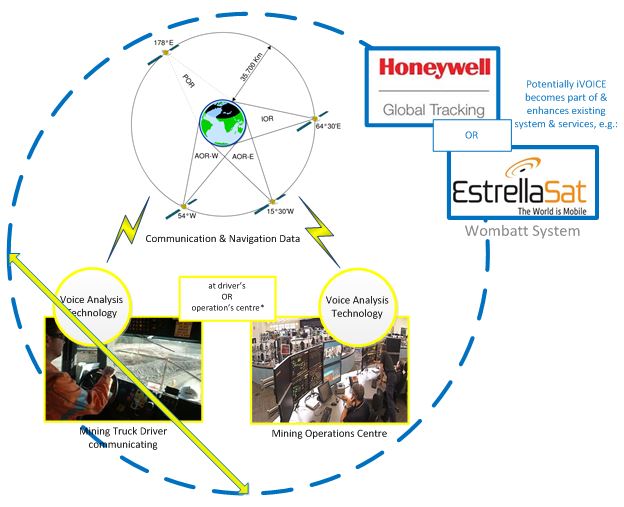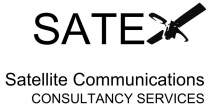Objectives of the service
Sixty five people die in open pit mines in Peru on average each year; around 60% of the fatal accidents are estimated to be due to operator fatigue, due to a driver falling asleep at the wheel. Additionally, near misses occur all the time and are carefully tracked by mine management. Currently, there are no non-invasive techniques that can be used to determine an individual’s level of fatigue and mental load while they perform their operational duties, although there are technologies starting to emerge to detect fatigue by other means (Caterpillar, 2008; ESA, 2013).
iVOICE technology deployed as part of the proposed VoiService is based on space communication and GNSS location services and is aimed at preventing situations where the driver becomes too fatigued to carry out his tasks safely. Its non-invasive nature increases acceptability to operators and through this improves the chance of being widely adopted, thus maximising the improvement in safety.
iVOICE will use existing signal processing and machine learning capabilities developed for linguistic analysis of speech for investigation of its paralinguistic properties, to monitor the health and psychological state of individuals by measurements made from audio recordings of their speech. This approach has many advantages to offer. Speech, as a neuromuscular performance, is affected by the physiological state of the individual which can affect the processes of respiration, voice and articulation as well as motor control and planning that goes in to speaking. In turn, the emotional state of individuals or their response to workload or stressful situations can affect their physiological state. Speaking is a natural part of many work and operational activities, while recordings of speech are easy to make, are non-invasive and generally accepted as necessary as part of a job.
Users and their needs
Initial Target users are in the Mining Industry:
Major (e.g. Rio Tinto (UK/Australia), BHPBilliton (Australia/UK) and Xstrata (UK/Switzerland)) and minor (e.g. STRACON GyM S.A, Chile)
Mining companies are being approached to integrate this technology in every-day operation to continuously monitor operators well-being and prevent costly mistakes, especially since these industries are already relying on satellite infrastructure and services for communication, data transfer and navigation services.
Target users in other industries:

Service/ system concept
The integrated solution uses two space assets provided via satellite:
1. Communication
2. Navigation
Communication and voice data captured from the operator analysed for mental strain and fatigue indicators, combined with operators’ location and vehicle movement (e.g. intended trajectory, proximity to objects, obstacles and other moving equipment/vehicles, using Satellite Navigation). Data is then transferred to supervisors and management via broadband data link (e.g. in national commercial telephone companies use a combination of micro wave, fibre optic cable, Satellite Communication to transmit data out of remote areas into the metropolitan area) and presented via graphic user interface or a more simplified alerting interface.
World-wide communications mean that the analysis can be performed locally and at remote sites and then displayed to Supervisors at the Mine Operations Centre.

Space Added Value
The iVOICE technology imbedded and integrated within operators’ natural working environment will provide the users with continuous assessment of each individual, particularly:
1. Monitoring operators’ levels of mental strain and fatigue, and
2. Alerting them when operators’ level of these states is approaching a detrimental level.
In the mining domain the remoteness of sites limits possible means of communication. Satellite communication links in combination with GNSS provide such safety and time-critical environments with high fidelity communications signal, allowing detailed analysis of communication coupled with drivers’ location data. As a result, users can timely detect the onset of detrimental levels of driver fatigue and intervene with appropriate corrective measures, knowing the location of the driver’s vehicle in relation to other operating equipment and dangerous areas. Using the proposed service utilising two space assets users do not need to rely on subjective, time-consuming, intrusive and no location/no real-time methods of assessing operators’ state of well-being.
Current Status
The iVOICE team has now completed the feasibility study and established the viability of the VoiService in the mining industry. All study objectives were achieved and the following tasks were performed:
• Evaluated improvements in existing voice analysis technology, coupled with high fidelity communications signal & GPS data
• iVOICE detected non-intrusively & objectively mental strain & fatigue in operators through voice in a controlled environment
• Investigated potential to develop services linked to high-risk & high-stress environments or dislocated domains
• Defined user, stakeholder, system and service requirements, as well as the iVOICE system architecture
• Conducted detailed market, economic and non-economic viability analysis
• Built the roadmap for the successful commercial deployment of the service in the mining industry in a partnership with EstrellaSat and WOMBATT.
The iVOICE team is now working on the preparation of a demonstration project proposal.






